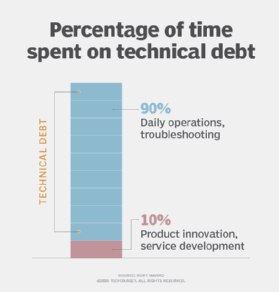
Getty Images
8 KPIs to reduce technical debt
To ensure an IT project's long-term success, stakeholders should keep track of certain KPIs to ensure technical debt is as low as possible. Learn more.
Dealing with technical debt is unavoidable. But certain KPIs can help project teams mitigate the problem and prevent issues later. Companies generally try to limit technical debt. Accumulating it might seem necessary at times, but project teams should avoid doing so if possible.
For example, consider the difference between deciding to add technical debt to hit a customer's go-live date and technical debt accumulating because the project team didn't follow the right processes, produce the correct documentation or perform sufficient testing. Adding technical debt in the first scenario is necessary, while doing so in the second scenario is avoidable.
To minimize technical debt, project stakeholders should establish certain KPIs that will signal whether too much technical debt is accumulating so the team can take corrective action.
Here are some of the KPIs that project stakeholders and other IT leaders can use to keep an eye on technical debt as well as some software tools that can help.
8 KPIs for assessing technical debt
Recognizing potential areas of technical debt in an IT project is critical so stakeholders can act if necessary. The following is a list of potential KPIs that can help project leaders mitigate technical debt.
1. Defects per line of code
The defects per line of code KPI compares the number of defects identified during testing to the number of lines of code written. The reason for the code change affects the ratio. For example, developing a completely new feature will show up differently in the ratio than improving an existing feature.
2. Technical debt ratio
The technical debt ratio KPI measures the money spent to fix or debug software issues compared to the money spent on creating the software.

3. Time spent
Tracking how a developer spends their time will provide good insight into the application's potential technical debt. The project team can measure time spent using timesheets with different codes for different actions, such as a code for addressing defects. Measuring time spent also helps the project leader account for the tasks that have been delayed because of unplanned fixes.
4. Open defects
This KPI examines the number of open defects to closed defects. Considering the issue's severity is important when trying to improve this ratio. Closing multiple low-priority defects might improve the open defect ratio but increases the risk of customers running into serious problems.
5. Test coverage
The test coverage KPI evaluates the percentage of code that is tested using automated testing. The move to cloud computing and rapid software releases has made automated testing critical for reducing technical debt. Project leaders can also use test coverage tools to measure the amount of manually tested code.
6. Customer-reported issues
This KPI tracks the number of problems encountered by customers. The metric gives insight into the number of missed defects during the development and testing process. These problems might require emergency fixes and could potentially affect a company's reputation.
7. Code quality
This KPI measures the quality of the written code based on its complexity, cleanliness and language-specific items. Project team members can evaluate code complexity using software development tools and code reviews.
8. Cycle time
This KPI measures the amount of time required to fix defects. Some issues might be complex and require a significant effort to resolve. Project stakeholders might want to determine an acceptable average amount of time to fix an issue, as doing so can separate quick fixes from the fixes that might take more time.
5 tools to measure technical debt
Organizations have various options for measuring technical debt, depending on the project's requirements. The author chose the vendors for the list below using sources such as Gartner, G2 and vendor websites.
The products are listed in alphabetical order:
- Jira. Project teams can use this application to plan projects and track data, such as the defects that the team has identified and fixed. Jira can integrate with various software development tools and can simplify processes for software developers.
- SonarQube. This tool can analyze a developer's code as they write it to identify potential issues during testing. The application generates reports that help project leaders measure code quality over time.
- Stepsize. Stepsize works with project management tools like Jira or Linear. It can track and prioritize technical debt. The cloud-based app also offers additional features that project leaders can consider including, such as custom user roles.
- Teamscale. Teamscale can help software developers write code. The software provides metrics about code quality and can identify issues with the code in real-time as well as highlight new code so tests can focus on the new material.
- VFunction. This platform identifies architecture issues during the development process so the team can address any problems early on.
Eric St-Jean is an independent consultant with a particular focus on HR technology, project management and Microsoft Excel training and automation. He writes about numerous business and technology areas.







